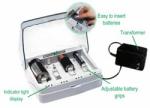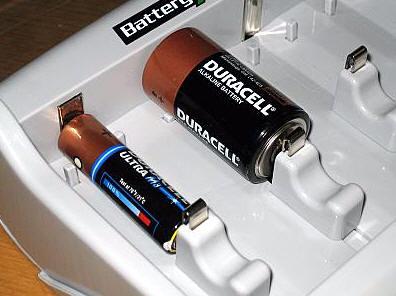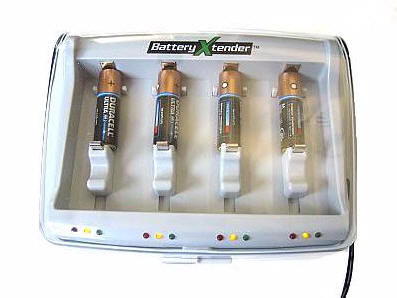
Alkaline battery technology was introduced in the 1950s, and it quickly became a major part of everyday life. According to a 2004 online report, approximately three billion household batteries are sold annually in the United States, "averaging about 32 per family or ten per person." As stated in this same report, in the year 1992 alone, approximately 101,400 tons of alkaline batteries were sold. Say it with me now..."GAH!"
Because alkaline batteries are single use items - meaning that they can't generally be recharged, it should be safe to say that just about all of those 101,400 tons eventually wound up in a landfill somewhere. Not counting disposals from years previous to 1992, and only figuring in disposals from 1992 to 2004, it could be said that in the past twelve years approximately 1,216,800 tons of alkaline batteries have made their way into landfills across the country.
In this world of portable gadgets and gizmos, alkaline batteries will probably continue to be a necessary evil for many years to come. Whether they be D cells for a flashlight, C cells for a walking robot, AA cells for a portable CD player, or AAA cells for a remote control, even in this day of rechargeable batteries there are still plenty of devices that call for the older single-use standard.
Other than the obvious issues that arise when such a massive amount of non-recyclable waste is disposed, additional environmental concerns have arisen because of the use of heavy metals in alkaline batteries. Because of those environmental concerns, both Energizer and Duracell have produced non-Mercury alkaline batteries since the early 1990s. Batteries now draw their power from the use of steel, zinc and manganese. According to the Duracell site, "It is important not to dispose of large amounts of alkaline batteries in a group. Used batteries are often not completely "dead." Grouping used batteries together can bring these "live" batteries into contact with one another, creating safety risks."
Well most of us know that there is usually still a little bit of life left in what we consider a "dead" battery ready for disposal, it just may not be enough juice to power the electronic device with which we were using it. Once the battery reaches that lower level of charge, it seems essentially worthless - but is it? Wouldn't it be great if there were a way to resuscitate the life back into an alkaline battery - to bring it back up to a usable level?
The idea of recharging alkaline batteries is not new, but Alkaline battery chargers have been offered to the public in the past, and they were not very successful because they did not live up their promise of creating reliable multi-use batteries from traditional alkaline disposables. I believe that there are also quite a few people who are reluctant to recharge alkalines because they believe the company warnings about possible ruptures and leakage if it is attempted.
When Think Geek approached us about reviewing the Battery Xtender Alkaline Battery Recharger, because it was a product they might be interested in carrying, I was skeptical to say the least. I think my first statement was along the lines of, "Ah, so I get to be the guinea pig?...well, what happens if the batteries blow up?!" But then curiosity got the best of me, and I agreed to try it out.
When the Battery Xtender arrived, the first thing I noticed was that it was a bit larger than the battery chargers I have used in the past, because it was made to work with D, C, AA and AAA cells. The charger measures approximately 6.5" wide, 5.75" deep, and 2.3" thick and weighs 14.2 ounces.

As you can see in this picture, there are four battery slots which can slide up or down to accommodate the various lengths of the different sized cells it will accept. There is also enough space in between the slots so that fatter batteries will not touch each other. An included wall charger plugs into a port on the right side.
According to the included manual, batteries should be checked for corrosion, leakage or other damage before they are inserted in the Battery Xtender. The Xtender is for indoor use only and is should be operated in an open area where air can easily circulate - never in a drawer or confined area. Since there is an outlet nearby, I decided to use it on the table in our breakfast nook.
The Battery Xtender is composed of an opaque gray plastic body with a transparent gray plastic flip-lid. The flip-lid is nice and thick which I was glad to see, because in the back of my mind I thought it might help protect my table when the batteries began to bubble and leak. Oh ye of little faith...
According to the manual, the Battery Xtender "is designed to recharge ordinary 1.2 to 1.5-volt alkaline batteries BEFORE they become discharged. Batteries rated from 1.2 to 1.5 volts can be safely placed in the charger. Nickel-Cadmium and Nickel-Metal Hydroxide operate between 1.2 and 1.25 volts. The Battery Xtender cannot recharge an alkaline battery if the battery is dead. NiCad and other rechargeable batteries recharge more fully when they have first been fully drained of power. This differs from ordinary alkaline batteries."
Now is a good time to mention that the Battery Xtender can be used not only with alkaline batteries, but also with Nickel Metal Hydroxide (NiMH), Nickel Cadmium (NiCad), Zinc Carbon, Titanium and Rechargeable Alkaline Manganese (RAM). There is a note that "Rechargers specifically designed for these types batteries may provide optimum recharging performance." However, Lithium batteries should not be used in the Battery Xtender. Because the Battery Xtender should only be used with those batteries which properly fit in its bays, meaning basically that the negative and positive points are on opposite sides and the battery is long enough to fit in the bay, 9-volt batteries and other oddly shaped or extra short batteries can not be charged in this device.
Batteries must be inserted with their positive posts against the stationary top and negative bases against the spring loaded sliding negative contact. AA and AAA batteries fit in between the spring loaded posts shown below, whereas C and D cell batteries will press down the spring-loaded posts, indicating to the Battery Xtender the correct charging current for their size. Any combination of battery sizes can be used, and one to four batteries can be charged at the same time. Here you can see a AA battery next to a C cell. Notice how the posts are pushed in by the width of the larger battery?

Once the batteries are in place and the unit has been plugged in, it's time to pay attention to the red, yellow and green LEDs at the base of each battery's bay. Red indicates that either the battery has not been properly inserted or it is dead. Remember that a dead battery can't be recharged, so it will have to be discarded. As the following picture shows, a yellow LED will glow to indicate that the battery is charging. Once charging is complete, the LED will glow bright green and the current will be automatically shut of going to that particular battery.
The pictured set of four AA batteries has been used to charge my iPAQ 4700 in the BoxWave Battery Adapter for MiniSync. Even though the batteries were not completely discharged, there is a point (around 50%, if the built in gauge is to be believed) where these batteries just stop charging the power-hungry iPAQ. Throwing the batteries away at this point would be completely wasteful, as a 50% battery should still be good for something, just not for what I need it to do.
Now, according to the Battery Xtender's manual "it is a good idea to have two sets of batteries" that are used for a particular device, "one in use and the other set recharging. This will ensure that powerful batteries are always available and also promote longer battery life." If 50% life is as good a place as any to stop using a battery in order to more frequently charge it, then it would appear that the BoxWave Adapter and the Battery Xtender might be a match made in heaven.

According to the Battery Xtender site, "The "Battery Xtender" Alkaline Battery Recharger uses patented microprocessor control techniques to continuously monitor and control the charging of up to four batteries simultaneously. There is no temperature rise in the batteries being recharged, and careful control of the process ensures that there is no buildup of gas or pressure. Fifteen years of testing and improvement has gone into the development and as a result the performance has been fine tuned to achieve manifold increases in the number of times the original energy of the battery may be recycled through recharging. Other features of the battery charger include automatic adjustment of the charging currents in proportion to the size of the batteries being charged. These features have been the subject of additional patent applications."
One thing that slightly surprised me was the amount of charging time that the Battery Xtender takes. After inserting the batteries, I assumed that they would be done charging in three to four hours, like regular rechargeables. However this was not the case. It can take anywhere from 8 to 16 hours to recharge a set of batteries, depending on their amount of discharge. Eventually the Battery Xtender's LEDs will glow green green, but since no sound is made it may slip the user's attention that they are finally done charging. Thankfully, each individual bay will automatically shut off once a full charge is reached, and the alkaline battery will not be overcharged.
These four AAs took approximately ten hours to fully recharge. As long as I continue to recharge them before they are completely discharged (or "dead"), then they should last for multiple charges. Interestingly enough, it seems as if the recharged batteries are lasting about as long as they did when new, which I didn't really think was possible. I am currently on the sixth cycle of use and recharge - and so far so good! I am hoping to reach at least ten...
I have used the Battery Xtender with Duracell, Energizer and Rayovac "non-rechargeable" batteries. So far, I haven't run into any snags or issues - other than the longer than average charging time. Because this product does take a while to properly charge the batteries without overload, the previously mentioned battery management practice is key. If there are always a set in the charger that have just finished recharging, then once I hit a stopping point with the current set of batteries in a device I can seamlessly perform a swap.
The Battery Xtender has really surprised me because I didn't think it was possible to safely recharge alkaline batteries to a new-new capacity. Now that it has been repeatedly proven to me by this device, I am happy to recommend it. If you are tired of constantly replacing the alkaline batteries in your electronic devices, your kids' toys, or your AV remote controls, then you should take a look at the Battery Xtender. Not only will it help lighten the load on your wallet, it will also lighten the load on our landfills.
This article was originally posted to The-Gadgeteer.com




